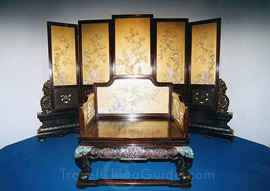Periods In Furniture

PERIODS in furniture are amazingly interesting if one plunges into the story, not with tense nerves, but gaily, for mere amusement, and then floats gently, in a drifting mood. One gathers in this way many sparkling historical anecdotes, and much substantial data really not so cumbersome as some imagine!
To know anything at all about a subject one must begin at the beginning, and to make the long run seems a mere spin in an auto, let us at once remind you that the whole fascinating tale lies between the covers of one delightful book, the "Illustrated History of Furniture," by Frederick Litchfield, published by Truslove et Han-son, London, and by John Lane, New York.
There are other books many of them but first exhaust Litchfield and apply what he tells you as you wander through public and private collections of furniture.
If you care for furniture at all, this book, which tells all that is known of its history, will prove highly instructive.
One cannot speak of the gradual development of furniture and furnishing; it is more a case of waves of types, and the story begins on the crest of a wave in Assyria, about 3000 years before Christ! Yes, seriously, interior decoration was an art back in that period and can be traced without any lost links in the chain of evidence.
From Assyria we turn to Egypt and learn from the frescoes and bas-reliefs on walls of ruined tombs, that about that same time, 3000 B. C., rooms on the banks of the Nile were decorated more or less as they are today.
The cultured classes had beautiful ceilings, gilded furniture, cushions and mattresses of dyed linen and wools, stuffed with downy feathers taken from water fowl, curtains that were suspended between columns, and, what is still more interesting to the lover of furniture, we find that the style known as Empire when revived by Napoleon I was at that time in vogue.
Even more remarkable is the fact that parts of legs and rails of furniture were turned as perfectly (I quote Litchfield) as if by a modern lathe. The variety of beautiful woods used by the Egyptians for furniture included ebony, cedar, sycamore and acacia. Marquetry was employed as well as wonderful inlaying with ivory, from both the elephant and hippopotamus. Footstools had little feet made like lion's claws or bull's hoofs.
According to Austin Leyard, the very earliest Assyrian chairs, as well as those of Egypt, had the legs terminating in the same lion's feet or bull's hoofs, which reappear in the Greek, Roman, Empire and even Sheraton furniture of England (eighteenth century).
The first Assyrian chairs were made without backs and of beautifully wrought gold and bronze, an art highly developed at that time.
In Egypt we find the heads of animals capping the backs of chairs in the way that we now see done on Spanish chairs.
The pilasters shown on the Empire furniture, Plate XVI, capped by women's heads with little gold feet at base, and caryatides of a kind, were souvenirs of the Egyptian throne seats, which rested on the backs of slaves possibly prisoners of war.
These chairs were wonderful works of art in gold or bronze. We fancy we can see those interiors, the chairs and beds covered with woven materials in rich colors and leopard skins thrown over chairs, the carpets of a woven palm-fiber and mats of the same, which were used as seats.
Early Egyptian rooms were beautiful in line because simple; never crowded with superfluous furnishings. It is amusing to see on the very earliest bas-reliefs Egyptian belles and beaux reclining against what we know to-day as Empire rolls, seen also on beds in old French prints of the fourteenth century. Who knows, even with the Egyptians this may have been a revived style!
One talks of new notes in color scheme. The Bakst thing was being done in Assyria, 700 B.C.! Sir George Green proved it when he opened up six rooms of a king's palace and found the walls all done in horizontal stripes of red, yellow and green! Also, he states that each entrance had the same number of pilasters. Oh wise Assyrian King and truly neutral, if as is supposed, those rooms were for his six wives!
In furniture, the epoch-making styles have been those showing line, and if decorated, then only with such decorations as were subservient to line; pure Greek and purest Roman, Gothic and early Renaissance, the best of the Louis, Directoire and First Empire, Chippendale, Adam, Sheraton and Heppelwhite.
The bad styles are those where ornamentations envelop and conceal line as in late Renaissance, the Italian Rococo, the Portuguese Barrocco (baroque), the curving and contorted degenerate forms of Louis XIV and XV and the Victorian all examples of the same thing, i. e.: perfect line achieved, acclaimed, flattered, losing its head and going to the bad in extravagant exuberance of over-ornamentation.
There is a psychic connection between the outline of furniture and the inline of man. Perfect line, chaste ornamentation, the elimination of the superfluous was the result of the Greek idea of restraint self-control in all things and in all expression. The immense authority of the lawmakers enforced simple austerity as the right and only setting for the daily life of an Athenian, worthy of the name. There were exceptions, but as a rule all citizens, regardless of their wealth and station, had impressed upon them the civic obligation to express their taste for the beautiful, in the erecting of public buildings in their city of Athens, monuments of perfect art, by God-like artists, Phidias, Apelles, and Praxiteles.
